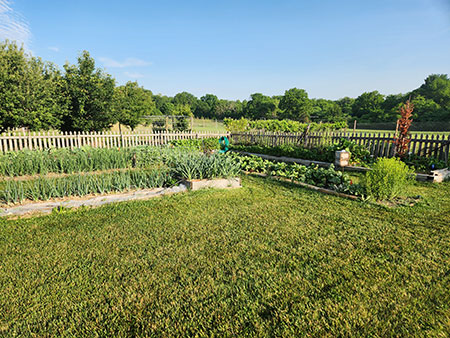Backyard Garden: Vegetable Garden I

This garden grows healthy vegetables targeted for local food pantries and uses techniques to maximize harvests. Our garden maintains a no-till and organic approach for planting, weeding, and pest/disease control
Points of Interest:
- Succession planting of a specific crop in “waves”:
- We are planting radishes at regular intervals (approximately two weeks) throughout the spring, so that we will have radishes available over a longer period. We will continue to plant/harvest until the harvest becomes bitter due to the heat.
- Succession planting of successive crops in the same area, after the initial crop is harvested.
- Most of our beds are used for both a spring crop and a summer or fall crop. For example, we have sugar snap peas and radishes as spring crops in a bed where sweetpotatoes will grow in the summer.
Intercropping: The simultaneous culture of two or more vegetables in the same garden space within the same growing season.
-
- In the spring, our small collard plants will be intercropped with spinach. As the weather gets warmer, the spinach will start to bolt – it will produce a flower stalk and the spinach will become bitter. We will remove the spinach plants at this point, providing more space for the collards to grow larger and continue to produce throughout the growing season.
- Vertical gardening:
- We are growing cucumbers on a trellis in the middle of a bed that will also contain rows of fall beets along the outer edges. In a similar fashion, we will grow sugar snap peas and radishes in the same bed.
- Our zucchini plants will be tied to a stake and the lower leaves will be removed to keep the leaves off the ground. Leaves on the ground typically provide protective cover for adult and nymph squash bugs. By keeping the leaves off of the ground, we are removing their protection. This technique has additional benefits of better air flow and easier harvest. Growing the plant vertically also allows intercropping
Tips:
- We don’t till.
- By not tilling, we don’t bring dormant seeds up to the soil’s surface allowing them to germinate. Additionally, tilling destroys soil structure and disrupts the beneficial soil biology such as microorganisms, fungi, nematodes, earthworms, protozoa and others that break down organic matter. These microorganisms also provide nutrients and aeration to the soil, assisting in soil drainage and moisture retention.
- Mulching is important to conserve moisture, regulate soil temperature, reduce weed pressure and add organic matter.
- We cover many of our beds with 2 layers of newspaper covered with straw. We find 2 layers of newspaper is effective and begins decomposing by the end of the season.
- Chopped tree leaves, collected each fall, can be applied a few inches deep to still allow soil oxygen exchange for roots, and make a great environment for sweetpotato vine nodes to self-root and grow more produce.
- Fertilize at appropriate times as needed by the plant growth:
- Tomatoes at first flower
- Onions/allium family three weeks after planting
- Sweetpotatoes at planting
- Consider pest exclusion. We use the following methods:
- Electric fence for raccoons
- Row cover for early insect pests and rabbits
- Tulle fabric for insect pests and rabbits (allows better airflow during summer heat)
- Try resistant varieties to further maximize your harvest.
- Celebrity tomatoes are a highly-productive determinate variety that tends to produce a majority of its crop at one time. They are resistant to many common tomato fungal and viral diseases. This year, we will grow Celebrity Plus, which is reported to have enhanced disease resistance when compared to Celebrity.
- Celebrity tomatoes also appear to have resistance to stink bugs, a problem in the Backyard Garden.
- Celebrity appears to have resistance to stink bugs, a problem in the Backyard Garden.
-
Garden Address
35230 W 135th St
Olathe, KS 66061
Master Gardeners are available to answer questions and provide tours while they work the gardens Wednesday mornings, March to October. To schedule a visit on another day (M-F), please contact us at bygjocoemg@gmail.comHave questions? The Garden Hotline is staffed by trained EMG volunteers and Extension staff who will assist you with questions.
Phone: (913) 715-7050
Email: garden.help@jocogov.org